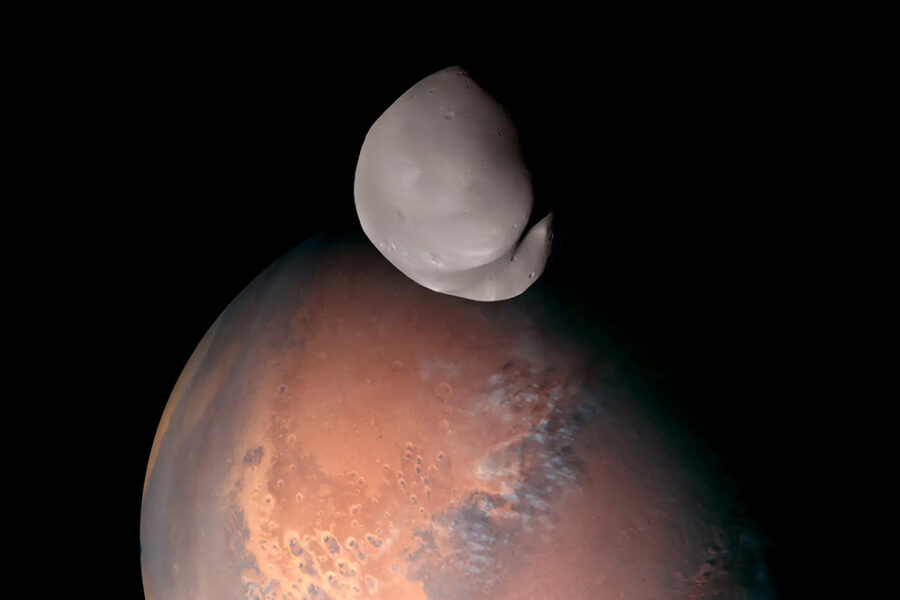The Emirates Mars Mission’s Hope probe has been observing the Red Planet since 2021. Now, surprising new results from the spacecraft call the origin of its smaller moon into question.

Emirates Mars Mission
The United Arab Emirates Space Agency’s Hope Probehas made important contributions to our understanding of Mars’ atmosphere, dust storms, and aurorae. At the annual meeting of the European Geological Union (EGU) in Vienna, the mission’s science team, led by Hessa Al Matroushi (Mohammed Bin Rashid Space Centre), presented the latest observations and imagery, along with an exciting “bonus” look at Deimos, Mars’s smaller moon.
Until now, all the satellites we’ve sent to Mars have had very close orbits in order to better study the planet’s atmosphere and surface. But the Hope team took a different approach, choosing instead to park the spacecraft in a large, elliptical orbit. This gives the team a “big picture” look at the Red Planet's atmosphere, including the ability to observe the full day-to-night cycle. Fortuitously, the wide orbit has also enabled the first close study of Deimos.
“Now that the mission has been extended, we feel more free to explore,” says Al Matroushi. “And it just happened that this orbit is also really good to give us observations of Deimos.”
Ground-based telescopes as well as Mars rovers and probes have taken pictures of Deimos. But now Hope has had the opportunity to observe the moon with high-resolution spectroscopy, which can tell us its surface composition and in turn shed light on its formation history. Using three instruments onboard — a camera, an infrared spectrometer, and an ultraviolet spectrometer — Hope found evidence that the moon is made of the same kind of rock as Mars is.
Deimos is one of two natural satellites of Mars (Phobos is the other), and both are in near-circular orbits. Both moons are small and irregularly shaped, and the rare, shadowy glances we’ve had of them in the past seemed to indicate that they are captured asteroids. But while scientists have largely assumed that they have a similar origin, we don’t know that for sure. The composition data previously available were pretty scrappy but could be fit to known “D-type” asteroid mineralogy, so that’s what the community went with. Scientists thought that an alternative scenario, where one or both of the moons were a fragment of the Martian surface freed via an impact, would result in bigger, rounder moons like our own.
In late January and February this year, Hope made a series of maneuvers that slightly changed its orbit so it could get a closer look at Deimos. The preliminary analysis of the spectra points to basaltic rock on the surface. Basalt is formed by volcanism, a phenomenon once present on Mars, but which we wouldn’t expect to see on a D-type asteroid. The presence of basalt could mean Deimos came from Mars’s surface via some sort of impact.
This is not a new idea. Captured asteroids would be unlikely to settle in stable, circular orbits, so scientists have dabbled in alternate origin stories over the years. In 2021, a team led by Amirhossein Bagheri (ETH Zürich, Switzerland) suggested in Nature Astronomy that Phobos and Deimos might have come from a larger moon. It would have formed in a giant impact, like Earth’s Moon, but later broke up and largely dissipated. Only a smattering of debris remained, reaccreting into Phobos and Deimos.
However, while impact scenarios have been proposed before, Hope’s observations provide the first real evidence for a non-asteroidal origin.
The Deimos data presented at the EGU meeting last week have not yet been peer-reviewed nor independently analyzed. Bradley Thomson (University of Tennessee), who is not on the team, wrote in an email that the consensus view is that Deimos is a captured asteroid, and until we verify with multiple high-resolution instruments, and eventually samples, there will always be some uncertainty.
“This is akin to a Discovery-class NASA mission, so finding answerable science questions can be tricky, but the mission planners have been clever about maximizing what they can accomplish within their budgetary confines,” he says. “The re-accretion of a disrupted moon is possible; some of the outer gas giants' moons are thought to potentially be reassembled.”
More observations, in different lighting, and ideally accompanied by surface samples are needed to build a robust case. It would also be nice if Deimos could be observed by different probes or telescopes with similar capabilities. But in the near future, Hope is the only spacecraft well placed to look at the moon.
Al Matroushi says that Hope will observe Deimos more in the coming year, alongside their primary and ongoing mission to study Mars’s atmosphere. Additional data should help clarify these intriguing preliminary results and, at the very least, give us a clearer picture of Deimos than ever before.
 3
3









Comments
PGT
May 9, 2023 at 8:51 pm
Every day, another astounding article from S&T.
Fantastic!
You must be logged in to post a comment.
Martian-Bachelor
May 17, 2023 at 12:09 am
Let me be the first to speculate that if this holds up then most of the martian meteorites collected so far might originate from Deimos (or maybe Phobos also). In spite of the much smaller cross section for impacts the escape velocity is virtually zero compared to the planet itself.
You must be logged in to post a comment.
Yaron Sheffer
May 17, 2023 at 12:48 pm
M-B, while the escape velocity from these tiny moons is, as you say, virtually zero, any rock would still have to climb out of the Martian gravitational well. And many would be captured by Mars itself just because it covers almost half of the sky as seen from those moons.
You must be logged in to post a comment.
You must be logged in to post a comment.